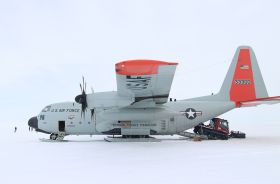109th Airlift Wing Launches Critical Resupply Mission For Greenland Science Station
CONTACT: Senior Master Sgt. William Gizara, 518-344-2423
The 109th Airlift Wing will launch a three-week mission to carry critical supplies to Summit Station, the only year-round science station that operates on the Greenland ice cap on August 4th. Three LC-130 Skibirds, supported by 20 aircrew members an...
Related Media
STRATTON AIR NATIONAL GUARD BASE, N.Y. (07/29/2020) The 109th Airlift Wing will launch a three-week mission to carry critical supplies to Summit Station, the only year-round science station that operates on the Greenland ice cap on August 4th.
Three LC-130 Skibirds, supported by 20 aircrew members and 40 maintenance Airmen from Stratton Air National Guard Base in Scotia, New York, will be delivering 280,000 pounds of fuel, around 40,000 gallons, and 30,000 pounds of food and other supplies in the shortened three week season.
Summit Station is operated by CH2MHill Polar Services for the National Science Foundation's (NSF) Arctic Research Program and hosts scientists conducting climate and other research.
It is the only high altitude, high latitude, inland, year-round observing station in the arctic, according to the NSF. The station will house five personnel throughout the winter.
"The missions our unit completes are critical to the lifeline of Summit Station and we are honored to continue to provide stability and support," said Col. Michele Kilgore, the commander of the 109th.
During the U.S. winter season, the 109th supports Operation Deep Freeze in Antarctica, and in the summer months, the unit normally flies to Greenland to not only continue their support for the NSF but to also train for Antarctic operations. This includes running the annual "Kool School" which trains Airmen in arctic survival techniques.
This year is different due to the COVID-19 pandemic. The unit will not perform any training and will only fly missions to Summit Station to resupply for the winter so they do not run out of fuel and food.
The wing's normal support season has been compressed from a normal five month support season. The season usually runs from April to August.
The ski-equipped LC-130 is able to haul much more cargo than smaller ski-equipped aircraft, making it the preferred choice to complete the resupply in a shorter amount of time.
Ski-equipped Twin Otters, made by Viking Air, a Canadian company, are used to swap personnel at the station but cannot deliver large amounts of cargo or fuel.
The fuel is being transported by filling up the planes' fuel tanks completely. Fuel that is not needed for the 836 mile, 4 hour roundtrip from the 109th Airlift Wing's base at Kangerlussuaq, Greenland to Summit Station, is then offloaded into fuel bladders and tanks at the station.
This allows the aircraft to carry both fuel and food at the same time, according to Maj. Daniel Urband, chief of 109th Greenland operations
This minimizes the amount of trips needs to resupply the station. The crews plan to complete three round trips a day during the mission, Urband said.
The Summit Station resupply mission demonstrates the key role that the 109th Airlift Wing plays in the arctic, Kilgore said.
A new Air Force Arctic Strategy document released on July 21 makes it clear that the arctic is a key region for U.S. defense and that the Air Force plays a vital role in the region.
The document specifically mentions the 109th Airlift Wing and the LC-130s as being vital in providing year-around access to Greenland and other arctic regions. The strategy also emphasizes that as the operator of the U.S. Department of Defense's only ski-equipped transport and contingency aircraft a substantial portion of the Department's arctic expertise resides in the wing's Airmen.
The new strategy commits the Air Force to working with partners in the arctic region, and the mission in Greenland, which is part of Denmark, illustrates this, Kilgore said.
"The release of the Air Force Arctic Strategy highlights our commitment to our partners during these times of uncertainty," she emphasized.
Because of the COVID-19 pandemic, the 109th has coordinated with the Danish government to minimize the risk of transmitting the virus. Precautions include quarantining before the trip and COVID testing prior to departure and while in country.

